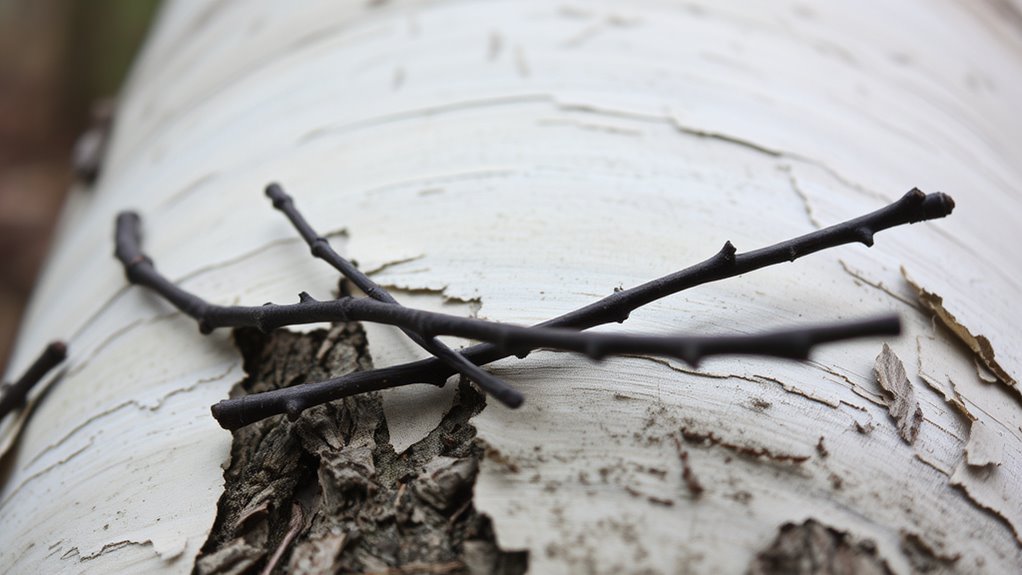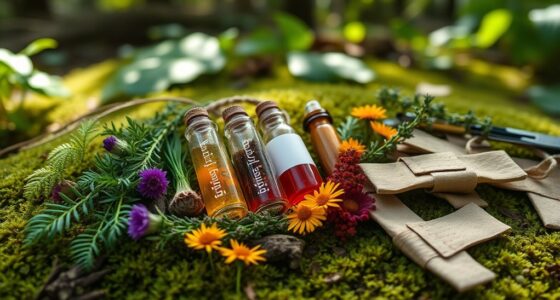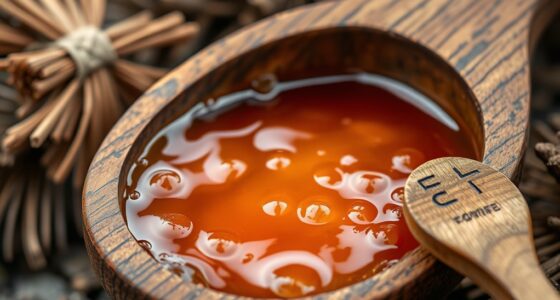Birch bark and twigs naturally contain salicylates, which are compounds historically used for pain relief and anti-inflammatory purposes. When harvested sustainably, you can collect these parts without harming the trees, ensuring they stay healthy. Modern extraction methods like cold water or ethanol infusions make it easier to isolate and concentrate salicylates effectively. If you keep exploring, you’ll discover even more ways to harness these natural remedies responsibly.
Key Takeaways
- Birch bark and twigs naturally contain salicylates, compounds with pain-relief and anti-inflammatory properties similar to aspirin.
- Traditional harvesting involves careful, sustainable peeling of bark and collecting twigs to protect tree health.
- Proper collection methods preserve the plant’s natural salicylates and support ecological balance.
- Modern extraction techniques enhance salicylate yield and potency, enabling effective natural remedies.
- Recognizing diverse plant sources expands herbal options for anti-inflammatory treatments beyond birch.

Birch bark and twigs contain natural compounds called salicylates, which are chemical substances also found in aspirin. These compounds have been recognized for centuries for their pain-relieving and anti-inflammatory properties. Yet, understanding how to access these salicylates from the wild isn’t just about tradition; it’s about reclaiming your own health and sovereignty over natural remedies. You don’t need to rely solely on pharmaceuticals—nature provides the tools, and modern techniques can help you harness them more efficiently.
Traditional harvesting methods honor the plant and ensure sustainability. When you carefully peel bark or collect twigs, you’re participating in a time-honored practice that respects the plant’s life cycle. This approach involves selective harvesting—taking only what’s necessary without damaging the tree—and allows the birch to continue thriving. It’s about forming a relationship with nature, understanding that these trees have been offering their healing compounds for generations. You’re part of a movement that values harmony over exploitation, and by adopting traditional methods, you embrace that philosophy.
But tradition isn’t enough on its own if you want consistent, potent salicylate extraction. That’s where modern extraction techniques come into play. These advanced methods enable you to isolate and concentrate salicylates more effectively than ever before. Using techniques like cold water extraction, ethanol infusion, or even supercritical fluid extraction, you can maximize yield while preserving the plant’s integrity. These methods are more precise, safer, and faster—empowering you to take control of your health journey without unnecessary waste or guesswork. It’s about merging respect for tradition with the advancements of science, creating a balanced approach that liberates you from dependency on synthetic medicines.
Additionally, understanding the diverse sources of salicylates can help you identify other plants and natural remedies with similar properties, broadening your herbal toolkit.
Frequently Asked Questions
Are Salicylates in Birch Bark Safe for All Skin Types?
Salicylates in birch bark aren’t safe for all skin types, especially if you have skin sensitivity or allergies. Natural remedies like birch bark can be powerful, but they might cause irritation or allergic reactions in some people. It’s essential to test a small patch first and consult with a healthcare professional if you’re unsure. Embrace your skin’s uniqueness and choose remedies that empower, not harm, your natural beauty.
Can Salicylates From Birch Cause Allergic Reactions?
You might face a storm of allergic reactions if you have birch allergy or salicylate sensitivity, as the compounds in birch bark can ignite skin flare-ups. Salicylates from birch can cause allergic reactions, especially if your immune system is sensitive. Don’t let these triggers chain you down—know your body, and if you notice redness or irritation, steer clear to reclaim your skin’s freedom.
How Do Salicylates in Birch Compare to Synthetic Aspirin?
You’ll find that natural salicylates in birch differ from synthetic aspirin mainly in extraction methods and purity. Natural salicylates come directly from birch bark, offering a more holistic approach, while synthetic aspirin is chemically refined and standardized. This difference can influence how your body reacts, potentially reducing allergic responses with natural sources. Embrace the freedom to choose, knowing that natural extraction preserves more of nature’s balance compared to lab-made alternatives.
Are There Any Medicinal Benefits of Salicylates in Birch?
Yes, the salicylates in birch have traditional medicinal benefits, especially for those seeking natural remedies. You can harness their anti-inflammatory properties to alleviate pain, reduce swelling, and fight fevers. Historically, people used birch bark and twigs to support healing and promote wellness. Embracing these natural options allows you to reclaim your health and experience the healing power of nature, free from synthetic drugs.
How Does Salicylate Concentration Vary Among Birch Species?
You’ll find that salicylate levels vary significantly among birch species, with paper birch having up to twice the concentration of yellow birch. This species variation is heavily influenced by environmental factors like soil richness and climate, which can boost or reduce salicylate production. Embrace the diversity—your choice of birch can enable different medicinal potentials, giving you the freedom to harness nature’s healing power tailored to your needs.
Conclusion
Next time you’re outdoors, remember that birch bark and twigs contain natural salicylates, the compounds similar to aspirin. Did you know that birch bark has been used for medicinal purposes for thousands of years? Surprisingly, studies show that birch trees can contain salicylate levels up to 0.5%, making them a potent natural remedy. So, next time you spot a birch, consider its potential health benefits and the fascinating chemistry it offers right in the wild.









